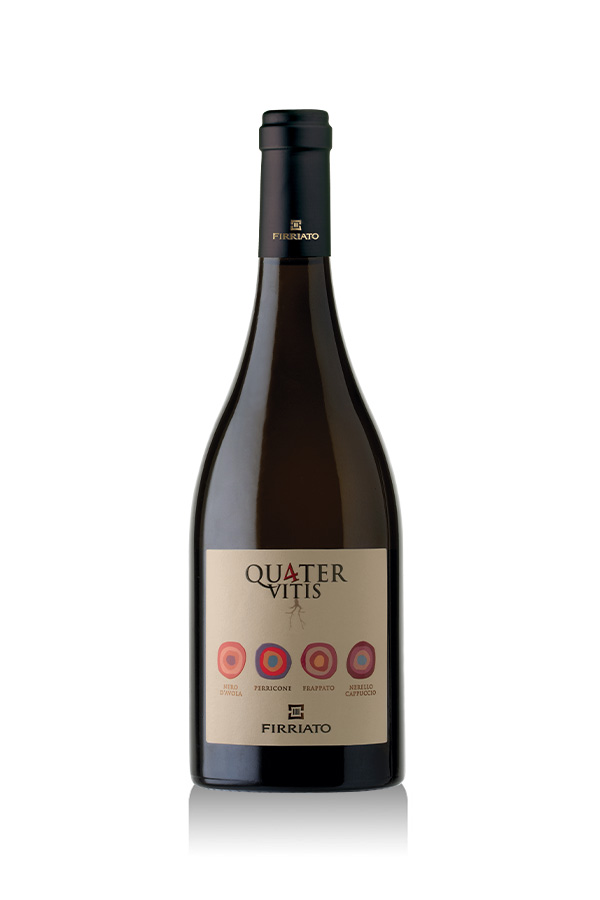The essence of Sicily in a wineglass
QUATER VITIS ROSSO
D.O.C Sicilia
Perricone, Nero d’Avola, Frappato and Nerello Cappuccio
Quater Vitis Rosso encapsulates wine-rich Sicily in a glass. It is a blend of Nero d’Avola, Perricone, Frappato and Nerello Cappuccio. It comes from four different grape harvests, followed by as many separate vinifications which all enhance the uniqueness of each single variety. Each single wine is aged in American and French oak, for a maximum of 10 months. The different woods give different wood notes that unite in nuances of vanilla. The best cuvees obtained from this then undergo assemblage, giving life to this wine which harmoniously enhances the fragrances of red fruit from the Nero d’Avola, the freshness from Frappato, the spicy notes of Nerello Cappuccio and the elegance of Perricone.
- Appellation: D.O.C Sicilia
- Vine: Perricone, Nero d’Avola, Frappato and Nerello Cappuccio
- Terroir: hilly
- Soil: clayey soils
- Exposure: from 200 to 250 m a.s.l.
Production Area
Pianoro Cuddìa

Covering 35 hectares, Pianoro Cuddìa is an extreme terroir because it is extremely rich in sodium, a property which obstructs and slows down the normal productive life cycle of the plants. This negative factor which could be a disadvantage has become a favourable and valued property for Firriato.

Quater Vitis Rosso
A blend of four native Sicilian vines
The four crus of Quater Vitis Rosso express all the personality of their four Sicilian native vine varieties. Each follows an individual and different vinification process, before being harmoniously united, after careful tasting for the right level of maturity, in a single wine. Quater Vitis Rosso is produced using each year’s best grapes—the Nero d’Avola, Perricone, Frappato and Nerello Cappuccio.
These vine varieties are cultivated using different agronomic techniques for each vine and their grape harvest times are also different. The harvest is completed between mid and late September. Harvesting by hand allows selection of the grape bunches, these are then arranged in wooden crates so that the grapes’ perfect integrity is not compromised. As the grapes gradually reach the winery they undergo a further selection for starting their individual processes of vinification and ageing in separate tanks and barriques. This way each cuvee can best enhance the characteristics of each grape variety.
QUATER VITIS ROSSO
The characteristics of vintages
2019
The 2019 viticultural cycle was significantly influenced by climatic conditions, characterized by higher humidity and cooler temperatures compared to previous years.
2018
The 2018 vintage in Trapani was characterized by frequent rains, and then stabilized during the final phase of grape ripening, with temperatures on average cooler than in 2017 and with good temperature variations between day and night.
2016
One of the best vintages that Sicily has ever had together with 2014, characterized by a balanced and gradual climatic trend. Winter is characterized by low rainfall followed by a spring season which began with cool temperatures, even during flowering; some precipitation occurred in the months of May and June.
2015
In the estates of the Agro di Trapani, the satisfying spring rainfall, followed by a very hot summer with abundant rainfall during the first days of August, favored, in addition to the restoration of the soil’s water resources, a good ripening cycle of the red grapes.
2014
It was an unforgettable vintage thanks largely to an almost uniform and very balanced climate, the spring was rightly rainy with cool summer which favoured ripening slow and gradual. There is talk of “a summer without Scirocco wind”, July is spent without excessive heat. Parallel there were recorded temperature day/night very marked in all companies Firriato which helped the development of aromas and flavours.
2013
Very fruitful vintage both for production and quality grapes which originated very interesting wines under sensorial profile. Grape harvest lasted until the last week of September. 2013 vintage enabled a slower grape harvest which included more gradual ripen process: the harvest had been delayed by two weeks.
2012
Normal vine growing cycle during blooming and fruit set periods. No unconventional event over veraison and ripeness times. Early white grapes are harvested in advance compare to last vintage. African summer anticyclones Caronte and Lucifero play a key role for vintage 2012, marking the quality of grapes. High temperatures dried bunches making water evaporate.
2011
The rainfall this year was lower compared to average rainfall values for Sicily and mainly occurred during the spring. The cool temperatures and scarce rainfall had a significant effect on the harvest, which began on different days for each variety (8th September for Frappato, 10th September for Perricone, 12th September for Nero d’Avola and last of all 13th September for Nerello Cappuccio), with a slight reduction in yield.
2010
At Pianoro Cuddìa, September marks the start of the harvest for the extremely fine fruits of the four autochthonous Sicilian red grape varieties: Nero d’Avola, Perricone, Frappato and Nerello Cappuccio. Overall, 2010 saw lower than average rainfall and temperatures, with abundant rainfall at the end of autumn and spring. This favoured a period of rest followed by invigoration of the vines, even though there was a slight delay in bud break and flowering.
2009
The weather conditions were variable in 2009 with abundant rainfall during the winter, evenly spread throughout the spring and plentiful from the middle of September. It was a very unusual year, notable for the low temperatures recorded during one of the coldest winters experienced in the last few years. The summer was warm and dry until the rain arrived at the end of the summer months.
2008
The scarce rainfall and mild temperatures recorded this year did not affect the growth of the vines, which produced healthy, ripe fruit, a small percentage of which was treated with sulphur. At Pianoro Cuddìa, the harvest of the four autochthonous varieties started on 8th September with Frappato, followed by Nero d’Avola, Perricone and Nerello Cappuccio over the course of the next few days.
2007
The productivity of the vines fell by 40% this year due to an attack of peronospora, a mould that develops after abundant rainfall, and the strong and persistent sirocco wind. Timely action from those caring for the plants managed to save them and although the yield was lower than in previous years, the grapes ripened perfectly producing sweet, aromatic fruit.
2005
The favourable weather conditions of 2005 and the perfect condition of the vines from the previous year resulted in an excellent harvest, perhaps one of the best in recent years. The labourers on the Pianoro Cuddìa estate began harvesting the grapes by hand on 7th September, starting with Frappato, then proceeded five days later with Nero d’Avola, then 14th September for Perricone and ended with Nerello Cappuccio on 16thSeptember.
2006
The stable weather conditions resulted in normal and productive vine growth and ripening. Rainfall was plentiful during the winter and spring of this year, supplying the plants with the right amount of water. The summer was fairly hot and muggy, resulting in early ripening of the grapes, which were harvested from September 6th for Nero d’Avola, September 2nd for Frappato, September 12th for Nerello Cappuccio and September 8th for Perricone.


QUATER VITIS ROSSO
Awards
2020
Wine Enthusiast: 90 pts
2015
International Wine Report: 92 pts
Vini Buoni d’Italia: 3 Stars
Luigi Veronelli: 2 Red stars
Bibenda: 4 Red bunches
2014
James Suckling: 91 pts
Gambero rosso: 3 Glasses
Vini Buoni d’Italia: 4 Stars
Bibenda: 4 Red Clusters
Guida Essenziale ai Vini d’Italia: 89 pts
2012
Luigi Veronelli: 3 red stars
2011
Annuario dei Migliori Vini Italiani: 96 pts
Luigi Veronelli: 3 red stars
Bibenda: 4 red clusters
2010
Gambero Rosso: 2 black glasses
Annuario dei Migliori Vini Italiani: 90 pts
2009
Annuario dei Migliori Vini Italiani: 91 pts The best producer of the year
Bibenda: 4 Clusters
2008
Wine Enthusiast: 91 pts
Annuario dei Migliori Vini Italiani: 93 pts
Bibenda: 4 clusters
2007
Wine Enthusiast: 90 pts
Gambero Rosso: 2 red glasses -finalist 3 glasses
2006
Annuario dei Migliori Vini Italiani: 97 pts – The best Italian Red
Vini d’Italia – Gambero Rosso e Slow Food : 2 glasses
Sens of winecat.vini rossi:97 pts Sicily
2005
Luigi Veronelli: 3 red stars
Paired with
Porchetta
Take the bacon and pass it over the flame to burn any remaining bristles. Separately, boil the garlic heads for 10 minutes from the boiling point of the water; in another saucepan, cook the wild fennel. Then spread the pork belly, salt it evenly over the entire surface, season with fennel, rosemary, boiled and peeled garlic, chilli and a generous grinding of pepper.

















